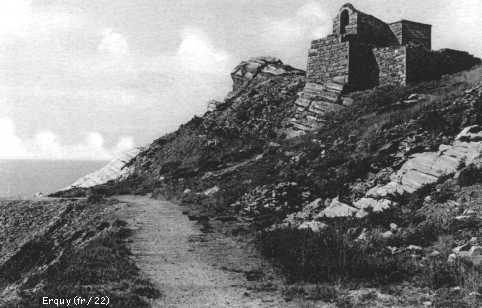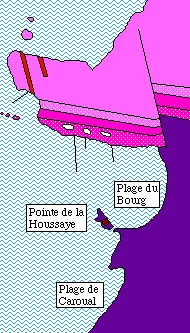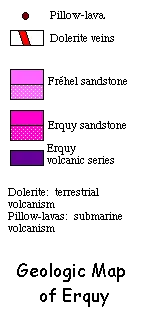



This is the bottom of an ocean... .an Armorican ocean. 
Quite a long time ago (some hundreds of millions of years), the region around Erquy was the center of intense volcanism... In fact, geologists have recognized two types of volcanism in the area :
1) The first: sub-marine, represented by lavas in the form of cushions called "Pilllow Lavas" located at Pointe de la Houssaye (Houssaye Point).
2) The second: terrestrial, represented by the dolerite at Cap d'Erquy (the Cape of Erquy).


 Map of the two types of volcanism at Erquy
Map of the two types of volcanism at ErquyPillows: Pillow lavas are characteristic of sub-marine volcanic emissions like ones occurring today near Iceland and like ones which occurred in the Alpine ocean (which has since disappeared) and, of course, in the department of Côtes d'Armor even earlier in time. Therefore, when looking for oceans that have disappeared, look for the "pillows".
Veins of dolerite oriented NS in the Fréhel sanstones are the result of fissural volcanism. Green boulders of dolerite in the bay of Port Blanc, behind the abandoned lifegurad building, are the easiest means of observing this rock type. Dolerite veins are also found near the caves located next to Châtelets on the north coast.
This dolerite comes in a diversity of colors: it is green when it is eroded into boulders by the waves and rust colored when it is exposed to open air (oxidation - alteration).


This schematic indicates the sequence of beds. Here they are shown in horizontal position as they would have been before the Hercynien orogeny and folding event.
In reality, this group is today inclined to the north. Since the youngest beds are also inclined (Fréhal sandstones which date to about 400 ma), the folding had to have happened afterwards (around 300 ma).
This schematic also indicates the different hardnesses of the rocks (differential erosion). It is also useful for understanding that the volcanic structures are not dikes but sills (more or less horizontal).

A sill of lava with pillows between two sedimentary beds. This is not a dike: remember that, due to the folding, the beds have been tilted to almost vertical.
The cushion or pillow shapes, called "pillow-lavas", are proof of submarine volcanism.
Dating this sill poses a problem for geologists who hesitate between the Precambrian and the Paleozoic.
Photo taken on the south coast of Houssay Point.
Translated by : Talia Henze, B.S. in Geophysics and B.A. in French from Western Washington University, Bellingham, Washington, USA.
Bibliography : GUILLAUME Michel, Géologie des Côtes-du-Nord, St-Brieuc : GEPN, 1986.